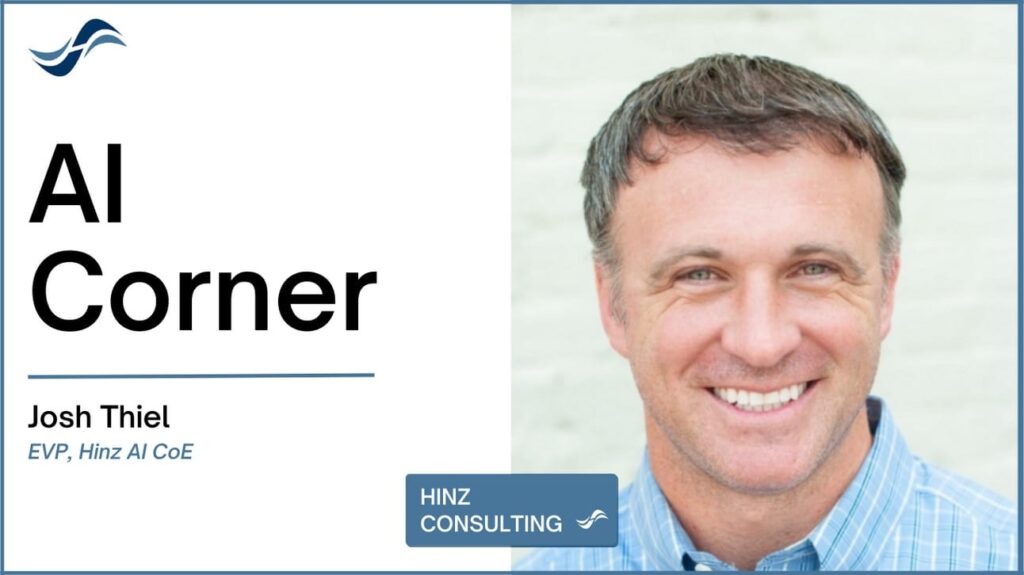In This Week’s Newsletter:
- Opportunity Spotlight of the Week: Department of Air Force and Space Intelligence Center, Advisory Support and Technical Requirement Administration (ASTRA)
- Four To Follow: Get the lowdown on four interesting pursuits
- Guest Feature: Cultivating Joy in the Workplace
- AI Corner: Selecting a Gen AI Platform: Ask About the Engineering Team
- Pricing Insights: Inflation and Escalation in Contracts
- Capture Corner: Value Case Importance

Department of Air Force and Space Intelligence Center, Advisory Support and Technical Requirement Administration (ASTRA)
Contact Katie: katie.clatterbuck@hinzconsulting.com
The Department of Air Force requires Advisory and Assistance Services (A&AS) contract support for research, development and sustainment of new and existing hardware, systems, and software capabilities, enabling scientific and technical intelligence production. This $480M BPA is estimated for release in May 2025 with a projected award timeframe of September 2025. Continue to monitor SAM.gov for updates.

Four to Follow:
- Department of Homeland Security (DHS), Enterprise Automation and Unified Task Orchestration. On April 11, 2025, DHS released a statement through APFS changing the requirements title from Enterprise Infrastructure Operations and Support Service (EIOSS)-2. Solicitation release has also been changed from July 2025 to September 2025. The support services will include infrastructure, cloud, unified communications, platform operations and sustainment, change & configuration management, and project management services. The Contract Type is currently unknown with the estimated value between $50M to $100M. Continue to monitor SAM.gov and APFS.gov for further insight into this effort.
- National Geospatial-Intelligence Agency (NGA), Operations Development and Innovation III (ODIN III). On April 3, 2025, NGA released a Sources Sought through https://acq-ui.westfields.net.Responses are due no later than 4:00PM ET April 30, 2025. This $50M opportunity is estimated for release in or around July 2025 with a projected award timeframe of March 26, 2026. Continue to monitor SAM.gov and acq-ui.westfields.net for further updates.
- Department of Air Force, US Space Force, Intelligence Systems Capabilities for Space Request. On April 10, 2025, the US Space Force released a Sources Sought notice for contractors to provide intelligence systems and capabilities for space. Responses to this Sources Sought are due via email no later than July 15, 2025, at 12:00 PM MT. The competition type and estimated value are currently unknown. Continue to monitor SAM.gov for further updates.
- National Geospatial-Intelligence Agency (NGA), Geophysical Data Purchase and Survey Sourcing. On April 7, 2025, NGA released an RFI to understand how the industry currently acquires geophysical data from external sources. This information will help coordinate direct surveys (airborne, marine, or land-based) of geophysical data. Responses are due no later than April 21, 2025, at 5:00PM CDT. The competition type and estimated value are currently known. Continue to watch SAM.gov for further information regarding this opportunity.
Guest Feature: Cultivating Joy in the Workplace
Alison French, a partner and trusted advisor of Hinz Consulting, and I were speaking the other day about how to improve the workplace for employees and productivity. I was shocked to hear her immediately bring up the term “joy.” Here is what Alison had to say…
“We started talking about how to bring joy into their workplace. Yes, even now. And this isn’t just a feel-good idea—it has brain-based benefits. Research from the University of Warwick found that employees who feel joy are up to 12% more productive than their less joyful counterparts. This boost in productivity is attributed to the release of hormones in the brain, including dopamine, serotonin, oxytocin, and endorphins, which help lower stress and enhance creativity. And research from the iOpener Institute and the Wall Street Journal found that these same employees:
- Are five times more loyal to their employers
- Are six times more energized
- Help their colleagues 33% more
- Achieve their goals 31% more of the time.
As leaders, it’s our job to help employees find those moments of joy – they need not be large or long-lasting, just to be unearthed. Where to start? As I advised my client, look first within yourself. Find that small thing that brought you a sense of joy – maybe it was the sun this morning or your dog greeting you excitedly – and spend a few moments reflecting on its feeling. Now do this every day and model it with your team. By creating this Joy Practice, you can not only enhance individual well-being but also drive organizational success.”
Alison French is the Managing Director of Alto Solutions, LLC, and works with organizations and their people to navigate change, improve leadership and communications, and build strong teams. Her May 15 workshop, “Own Your Journey – Reclaim Your Joy,” is open to the public.

Selecting a Gen AI Platform: Ask About the Engineering Team
Contact Josh: josh.thiel@hinzconsulting.com
When considering a Gen AI platform, it’s crucial to inquire about the vendor’s engineering team. With technology evolving at lightning speed, asking a few fundamental questions about the engineering team can reveal whether the company can keep pace with technological advancements, perform maintenance, and improve the product, or if they are more focused on flipping rather than building a strong brand in the industry.
Question 1: How big is your engineering team?
Considerations: Series A and B Gen AI companies typically have 4-7 teams, each consisting of 5 engineers. This structure allows companies to conduct system maintenance and execute sprints for new features.
Question 2: How long has your senior engineering leader been in place?
Considerations: Building up a platform, forming a cohesive team, and consistently executing at a high level takes time. Stability in the senior engineering position is essential.
Question 3: What is the composition of your engineering team, and how diverse are they?
Considerations: Diversity brings different perspectives and enhances problem-solving. All forms of diversity matter, including degrees, job experience, specialization, ethnicity, and gender.
Question 4: Can I see the roadmap?
Considerations: When reviewing the roadmap, don’t just focus on future plans. Look at past performance to see if features have been delivered on time.
Ultimately, you want to select a Gen AI platform that addresses your pain points and offers a high ROI. Asking about the engineering team can offer valuable insight into the vendor’s ability to innovate and support future needs.

Inflation and Escalation in Contracts
Contact Tom: tom.hudgins@hinzconsulting.com
Company XYZ sees that inflation has reached record levels, now exceeding 9%. Seeking to win new contracts and use those potential awards to boost profits, the company instructs its personnel to escalate all pricing in line with inflation.
However, including a 9% escalation in a federal government proposal presents several challenges. First, it can be difficult to justify in the Basis of Estimate (BOE) or pricing narrative—especially when the government typically expects escalation rates between 2% and 4%, regardless of broader inflation trends. Second, if the proposal is based on a pre-established pricing schedule, such as a GSA schedule, escalation is capped at the rates specified in the contract—usually around 2% to 3%. Finally, there’s the issue of competitiveness: the higher the proposed escalation, the higher the overall price, which can make the bid less competitive.
So, what can companies do to mitigate the risks associated with inflation? Below are several strategies that can help, though each may come with its own potential risks/trade-offs.
- If the bid is based on a cost/price buildup, use information from Bureau of Labor Statistics (bls.gov) Consumer Price Index (CPI). BLS CPI is easily justifiable. If the bid is based on a GSA schedule, you are capped at what escalation you can use.
- Propose an escalation factor between the BLS CPI and the published inflation—but ensure that the inflation source is credible and well-supported.
- Propose a factor slightly higher than the current CPI, then slightly decrease escalation in outyears.
- Propose a factor slightly higher than the current CPI for short-term contracts (less than five years), propose a factor at or slightly below the current CPI for long-term contracts (more than five years in duration).
- Request an Economic Price Adjustment on your contracts. Work with the applicable contracting officer.
- Continue to price as normal. Inflation goes up, inflation goes back down.
Bottom line: If you want to be competitive and win, you must keep costs down. Avoid submitting escalation factors that simply mirror inflation—proposing a 9% escalation in a federal bid is unrealistic. High inflation does not mean the government will automatically accept elevated escalation rates. Winning companies understand this and structure their pricing accordingly. As for the execution—wise, disciplined program/project management is key to delivering value and maintaining margins.

Value Case Importance
Contact John: john.amoriello@hinzconsulting.com
During the Pre-RFP phase of a pursuit, it’s important to define the value case of your offering to the client. A value case approach to the bid should guide your Pre-RFP planning and shaping activities and include the following elements:
- Clarifies the “Why”: Articulates why the effort is worthwhile by defining the benefits of your offering—such as cost savings, increased efficiency, and strategic alignment with project.
- Aligns to Stakeholders: Ensures stakeholders alignment and understanding of desired outcomes, helping prioritize procurement goals and influence objectives.
- Supports Decision Making: Provides a foundation for informed decisions by helping stakeholders evaluate scope and enabling leadership to assess procurement priorities.
- Guides Scope and Procurement Focus: Helps the client define what success looks like and identify the most valuable elements to pursue.
- Establishes Measurable Outcomes: Includes key metrics, enabling the customer to track value realization over time.
- Informs Risk Management: Details expected value to help organizations assess risk and develop mitigation strategies if the projected value is not realized.

- April 23-24: DSO Day Darpa in Chicago, IL
- May 4-10: National Small Business Week SBA – Virtual
- May 5-8: SOF Week in Tampa, FL
- May 13-16: VETS25 Conference in Orlando, FL
- May 18-21: BPC Nashville 2025 in Nashville, TN
